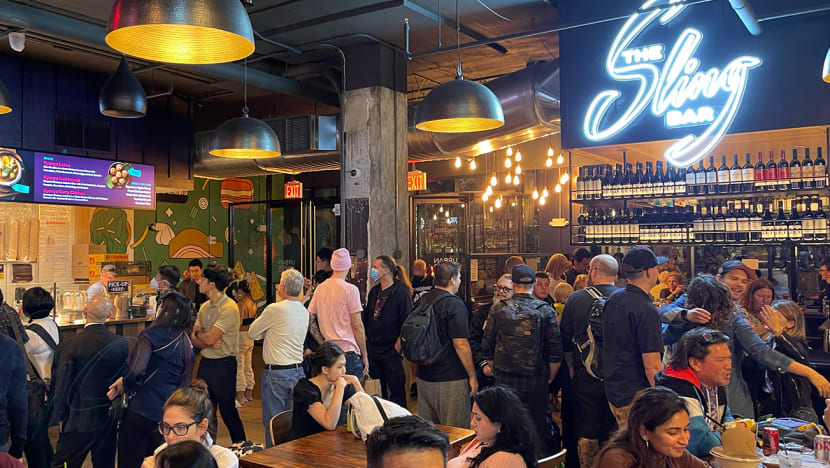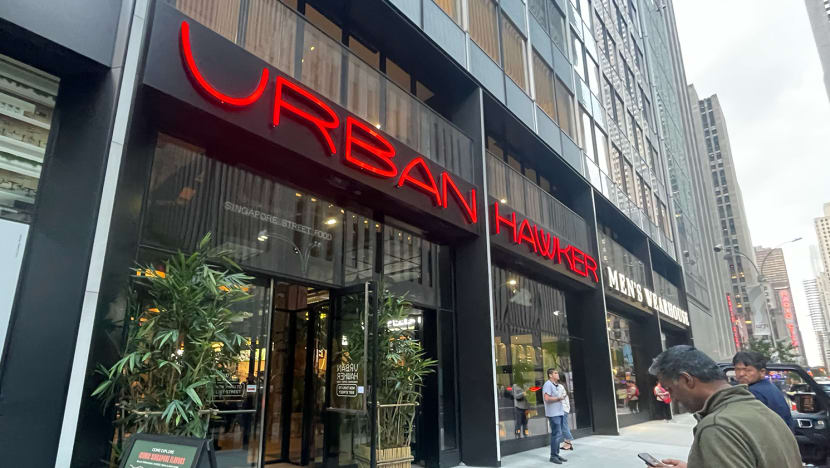Singapore F&B businesses, hawkers eye further expansion across US after initial success
This is despite having to navigate around various challenges such as local regulations and sourcing for some ingredients.

The crowd at Singapore-style food centre Urban Hawker located near Times Square. (Photo: Nicolette Wong)
SAN FRANCISCO: Singapore hawkers and food and beverage businesses are cooking up a storm in the American market, and have plans to expand across the country.
There is a big appetite for Singapore brands in the United States, with some businesses reporting good sales figures after venturing there.
This is despite having to navigate various challenges such as local regulations and sourcing for certain ingredients.
Now, these brands want to encourage other local names to expand into the US and leverage the food culture that Singapore is known for.
KEEPING UP WITH THE DEMAND
Singapore snack brand Irvins Salted Egg, for instance, has been in the US for just two years, but sales are set to double that back home within four years.
“Now, the situation is we can't supply fast enough. The demand is so strong with our products, we can't keep up,” said Mr Alex Uoo, senior vice president (North America) of the salted egg snack brand.
“Our main goal is to establish our plant facility in the US and have the salmon skin products be made here and also distributed to the US, Canadian and Mexico markets.”
Irvin, which is currently selling in California and testing products in Texas, plans to break into the food scene in other states such as New York and Washington in the coming months.
Meanwhile, Singapore household brand Killiney Kopitiam is set to open a second outlet at a mall in the Californian city of Santa Clara by next year.
“Because of how we opened during the pandemic, we first attracted the Asian people because of trust. Singaporeans know this brand,” said chef Nora Haron, the company’s culinary director.
“But now people are going back to work, so people are willing to try new foods, especially Americans who have travelled to Singapore and know what Singapore food is all about. So why not deliver that same thing? It's much cheaper to eat here than to fly to Singapore.”
However, it has not been an entirely smooth ride.
Ms Nora said opening a shop in the US takes around two years – six times slower than back home.
“Different states have different regulations, different cities have different regulations. So you really have to do your homework,” she added.
“We have a lot of red tape that we have to go through, challenges with the city, with the health department. All those checks and balances have to be done and they don't necessarily happen as fast as we want to.”
TAKING LOCAL FOOD ACROSS AMERICA
Over in New York, at least a quarter of the Singapore food operators at the Singapore-style food centre Urban Hawker are now looking to bring a taste of local delicacies to other states such as California.
“Opening in New York City gives us more opportunity to open in different states such as DC and LA, and we hope once we stabilise in New York, we will proceed with the expansion,” said Mr Aidil Iskandar Salman, operations director at Padi D’NYC.
Urban Hawker launched in New York City six months ago, with more than 10 vendors who flew over from Singapore to set up shop.
Since its opening last September, the stalls have seen an increasing number of American patrons.
At the start, their customer base was around 70 to 80 per cent Asians. But now, it is about half, a sign that more people are learning about Singapore's culture and heritage.
Some vendors are in talks with government agency Enterprise Singapore to open up in other cities across the US and further spread Singapore’s hawker culture.
But trying to provide an authentic experience in America comes with its challenges, hawkers told CNA.
“For example, it's hard to get calamansi over here, so we substitute with lime juice and fresh lime. And also for our chillies, we have to use a blend of Mexican chillies,” said Hainan Jones head chef Lim Wei Keat.
“For our dark soy sauce over here, it's a bit harder to find the thicker versions (found) in Singapore. So what we do is we do a home blend here to achieve that kind of consistency.”

WORKING WITH NON-ASIAN WORKFORCE
Operators also have to teach a largely non-Asian workforce how to make Singapore dishes from scratch.
"South Americans make up a very huge backbone of the food and beverage society over here,” said Mr Lim.
“One of the challenges is the language barrier. For myself, I have to speak a bit of Spanish and a bit of French to some of my workers here and that was hard for me at the start.”
But operators told CNA that business has been good, because their dishes are viewed as specialty items.
"I'm more profitable and also it's not so competitive compared to in Singapore, where there's maybe like two chicken rice stalls in a hawker centre,” said Mr Lim, adding that there is a ceiling for the selling price back home.
“This chicken rice dish is unique here. We can see it's more like a specialised thing where people come here specifically for chicken rice.”
This article was originally published on CNA.

No comments
Share your thoughts! Tell us your name and class for a gift (: